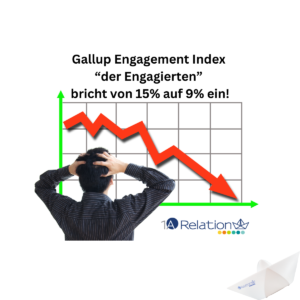With the help of business intelligence and analytics, exploit data in a meaningful way and take well-founded measures. Why Qlik View and Qlik Sense are particularly interesting for medium-sized companies.
The vision of Mike Capone, CEO of Qlik, is clear. His goal is “a data-literate world where people, businesses, organizations and governments use data to solve their biggest challenges.”
Jump now quickly and easily to the most interesting part of the article for you:
- Qlik Positioning – Did Salesforce’s purchase of Tableau influence Qlik’s strategy?
- Qlik and the middle class – a perfect connection?
- We were guests on Qlik’s Data Revolution Tour (DRT)
- Conclusion
On the way to this goal, Qlik is well on his way. The first milestone: Qlik is a leader in business intelligence. (Source: The BI & Analytics Survey 21 by BARC). The next milestone that Qlik is pursuing: Qlik wants to serve the “analytics economy” just as successfully.
To give you some information about the background and thoughts, we conducted an interview with Wolfgang Kobek, SVP EMEA of Qlik, and Matthias Herkommer, Manager Presales DACH at Qlik.


The conversation followed Qlik’s Data Revolution Summit. Our conversation had two main topics:
- Qlik Positioning – Has Salesforce’s purchase of Tableau (we reported) changed Qlik’s strategic direction?
- Qlik and medium-sized companies – a perfect connection? What makes working with Qlik particularly interesting from the user’s point of view?
Here are their answers on the topics:
Qlik Positioning – Did Salesforce’s purchase of Tableau influence Qlik’s strategy?
According to Wolfgang Kobek, Salesforce’s purchase of Tableau has even had a positive impact on Qlik’s new customer acquisition.
The simple reason: Many non-Salesforce customers who were faced with the choice between Qlik or Tableau chose Qlik as a result. Because the use of Tableau could create a greater dependency on Salesforce. Another reason: There was uncertainty about how Tableau would continue.
In addition to this uncertainty in the market, from which Qlik was able to benefit, Qlik gets further tailwind from the BARC study “The BI & Analytics Survey 21”. This study reflects the opinion of users of BI platforms and business analytics. The bottom line of the study is:
QlikSense and QlikView products perform very well among users in terms of customer experience and business value. In the competitive situation, Qlik wins especially with its good API Connector. This works very well for Salesforce, for example, but also for SAP and other providers.
Further information on BARC’s BI Survey can be found here.
The new path to data integration
Qlik, of course, watched the purchase of Tableau with interest. However, the company’s own strategy for positioning itself in the market has not been changed as a result. The goal of Qlik has been fixed for about 2 years and is: “From Raw Data to Insight”.
But what does that mean in concrete terms, we ask Wolfgang Kobek and Matthias Herkommer.
Qlik has been pursuing the path of data integration since that time. The determination of this decision is underlined by the acquisition of Attunity by Qlik in May 2019. Wolfgang Kobek emphasizes that “differentiation will no longer take place solely through our market-leading data analysis”. The Qlik portfolio now includes the preparation, analysis and visualization of data – all from a single source.
This step shows that in addition to the market leader position in the field of Business Intelligence (BI), Analytics Economy is now also to be filled. The extremely flexible integration of Qlik into other solutions is a success factor for this. But more on that in a moment.
From Insight to Action – What does that mean exactly?
The slogan “From Raw Data to Insight” describes Qlik’s positioning in the market. How does Qlik implement this promise on the technical side? Which path did Qlik choose?
Here it is particularly important to highlight the keyword “Active Intelligence”. In this area, Qlik has recently strengthened. In October 2020, the company acquired the Integration and Automation Platform (iPaaS) Blendr.io. This step brought over 500 interfaces to SaaS applications and cloud data sources. This allows Qlik to generate real-time data for SaaS applications and automated business processes. Qlik enables newly gained insights and – derived from this – to carry out or implement rapid measures in companies or to intelligently trigger automatisms beyond the pure analysis process.
Data is therefore not only provided in a prepared form. Qlik goes one big step further. For example, users in e-commerce who work with Qlik are given the opportunity to individualize and personalize data. This is exactly a success criterion for users. Not a mass, but targeted, personal, individual. According to various analyses (e.g. DDV study with the University of Kassel), this creates an additional contribution margin of 10% and more.
Strategic Partnerships
Qlik can also position itself strongly on the subject of strategic partnerships. More than ever, partnerships are an elementary component for positioning in the competition. They help to integrate Qlik into different systems and make it possible to accelerate technical development.
The most well-known names here are Amazon Web Services (AWS), Google Cloud or Microsoft. With these technically strong partners, Qlik is strategically very well positioned in the long term. With the own know-how and the interfaces through the cooperations, a wide field of customers is addressed.
In the fast-growing cloud application sector, Qlik is increasingly moving towards Software as a Service (SaaS). With Snowflake, there is an important partner when it comes to data warehouses. In this context, Matthias Herkommer once again emphasized that the Qlik Data Integration Portfolio has created a strategically important new ecosystem of partners and cloud platforms. This opens up new opportunities, such as working with Databricks as a Data Lake Partner. The business areas are opening up in the direction of data warehousing and data lake.
Qlik and the middle class – a perfect connection?
Why SMEs use Qlik
For every good CRM tool, a fully integrated BI solution is now the standard. Qlik can shine in implementing this standard. A great strength of Qlik Sense is the ability to be embedded in a variety of customer relationship software solutions. The integration, even within individual CRM applications, is made possible by the chosen API first approach. This makes Qlik Sense a viable solution for everyone. A customer thus gets its own business intelligence tools. This open approach is also followed in the strategic orientation towards SaaS. Here, too, all the interface solutions are integrated or available to the user.
We ourselves have already seen some CRM solutions in which Qlik is integrated with great satisfaction in practice.
The added value this creates is easy to describe. To stay with tableau comparison, this was a stand-alone desktop product with a flanged server. Over the past 10 years, Qlik Sense has evolved into a web-based and API-oriented solution. Characteristics like these now come into play, as customers are never interested in a pure analysis of CRM data. These can also be done through existing interactive dashboards. The demand of business intelligence is a higher one. Qlik Sense can be integrated into the user interface and now bring in additional data, such as from an ERP system. QlikView, on the other hand, offers advantages for power users. They can build tools tailored for themselves in QlikView. This individualization allows an even more specific use of the data.
How does Qlik enable its users to make the most of the tools?
In practice, it is often the case that the rate of “real users” differs greatly from the number of “possible users”. The most common causes of this discrepancy are, on the one hand, the lack of time to use it and, on the other hand, the ability to handle the data.
Qlik has launched a program for more data literacy in the user company to solve this problem and increase data literacy in companies. Data literacy describes the ability to collect, evaluate and apply data in a critical way. The necessary competence can be acquired in an individual way via consulting, training, as well as eLearning with the support of Qlik.
Qlik promotes data literacy through its products. These include “augmented tools” and drag-and-drop functions. This allows an individual dashboard for each user. Beginners are supported by best-practice chart suggestions and an intelligent search in natural language. For the developers of BI systems, Qlik offers “augmented intelligence” to bring data from different sources into a common data model. The relationship between data is already automatically analyzed and output to the developer through suggestions, so that an analysis data model is available more quickly after they have been reviewed.
How do I get started with Qlik as a newcomer?
Agile prototyping is becoming more and more popular. In practice, it turns out that agile development is the chosen path in the introduction of software. A use case is implemented as a pilot, this is not about complexity, but about a minimum viable product (MVP). In this case, the most basic functions are covered. However, these are sufficient to create an action-relevant product. In this MVP, the analysis can be tried or tested.
The more complex structures are now being successively followed. For example, the use cases of a data warehouse can first be validated and then set up together with Qlik Data Integration.
The success of Qlik’s customers is specifically supported by its own customer success department and its offers, such as an always-on package. The correct use of Qlik products is crucial. For customers, successful implementation is essential in the age of digital transformation. Because “the question is no longer whether the use of software for data analysis makes sense, but what damage occurs if I do not do it,” emphasize the two Qlik managers.
We were guests on Qlik’s Data Revolution Tour (DRT)
Qlik Data Revolution Virtual Summit 2020 for D-A-CH
Qlik’s virtual conference on the latest developments in data integration and analysis took place on 28.10.2020. The live events in the form of webinars included keynote presentations and interactive sessions delivered by industry experts, thought leaders and Qlik executives.
The summit will provide the latest information and strategies on how data can be transformed into companies and thus contribute to value creation. All presentations on topics such as “The new normal needs a new BI” or “From strategy to analysis” are available on demand.
We would like to highlight a lecture here at this point. Because he has remained in our heads through his simple, yet extremely useful way.
Being human in the age of the machine
In her keynote address, Dr. Hannah Fry deals with the topic of the relationship between people and data. Where it helps us and where it can’t (yet) help us, because we see the data as a human being.

Hannah Fry is Academic Councillor at the Centre for Higher Spatial Statistics at University College London and researches the mathematical description of human behavioural patterns. In her lecture, she shows how people think about themselves to be completely rational creatures. Based on this perception, they make their decisions. But being human means only one thing: chaos. Modern data analysis is an attempt at a corrective. It is intended to correct one’s own bias, but here too there are blind spots. People simply make mistakes. These errors are also evident in the machines they have devised. In order to avoid mistakes, people have to question data and use it in the right place. Or move on to including data from new, unusual, and disparate data sources.
A perfect practical example of networking and communication:
To illustrate this, Hannah Fry presents the following example: In the period from 2013 to 2014, there was a company in Hungary that had to carry out staff reductions at each of its three locations due to its economic difficulties. After this decision, a large number of rumors arose in the company. The content was mainly the number of layoffs and salary cuts, which worsened the morale of all employees.
In order to understand the origin and distribution of the rumors, a study was conducted among all employees, with the core question of who they address for advice and information. The result was a graphically prepared network in which a single person in particular emerged as a network hub.
This one person was therefore referred to by colleagues, more often than anyone else, as “the relevant source of information”.
In the eyes of the employees, the management as well as the top management had only a minimal relevance. So they were rarely approached by employees on important issues. This result is particularly interesting with regard to the flow of communication or the establishment of a relationship network in a company. It also shows the importance of individuals, regardless of hierarchies, function or position within the company.
Such a dramatic result is particularly astonishing, since in the case described, it was strategic decisions, and not everyday work. The most important hub is surprisingly found at the entry level of the company, namely with a safety officer. Said employee is responsible for compliance with and implementation of occupational safety at the various locations and thus distributed rumors or took new ones with him.
The company decided to give the safety officers a raise as well as a new role. From now on, the management used his insights for an improved exchange of communication, as it was now known which topics are relevant in the company.
This is a perfect example of the Qlik slogan: From Raw Data to Insight to Actionable Data.
The Morality of History’
The moral of Hannah Fry’s example above is to be able to gain reliable insights from data in the event of uncertainty or even the economic pressure situation of a company. In order to make this possible, a comprehensive understanding of what information each individual data pot or the collection method can provide is necessary. Even if a way of obtaining data is unusual, it must be considered. If such unusual ways are ignored, no decision-relevant data is available and added value is not possible. Opportunities are missed.
The same applies to the presentation of data. Depending on the chosen form of visualization, patterns and relationships can often not be recognized. When looking at data, the human viewer can be quickly steered in one direction or only sees what he wants. Hannah Fry again describes this succinctly using the example of the Challenger disaster. Instead of looking at data separately, they only looked at the overall context. However, a simple selection directly shows that launches under an outside temperature of 17 degrees Celsius were never successful. The appropriate presentation of data therefore facilitates the handling of data.
Conclusion:
The amount of data collected is not the problem in companies today. Rather, the challenge is to recognize the right data and the correlations. Thus, there is still a great risk that decisions will be made on an uncertain database.
Fry emphasizes that uncertainty can never be completely ruled out. Regardless of how data driven a company is.
The decisive factor is the human being. If a data analysis does not explicitly indicate a development or problem, it does not mean that something is not there. The decisive factor remains that the human being has to recognize patterns through his own abilities.
This requires regular training of skills and methods.
Note: This is a machine translation. It is neither 100% complete nor 100% correct. We can therefore not guarantee the result.












